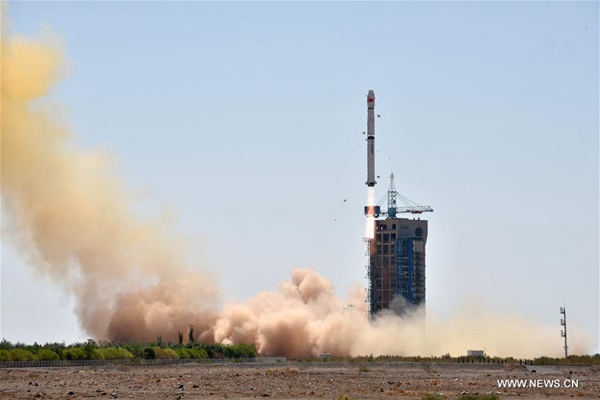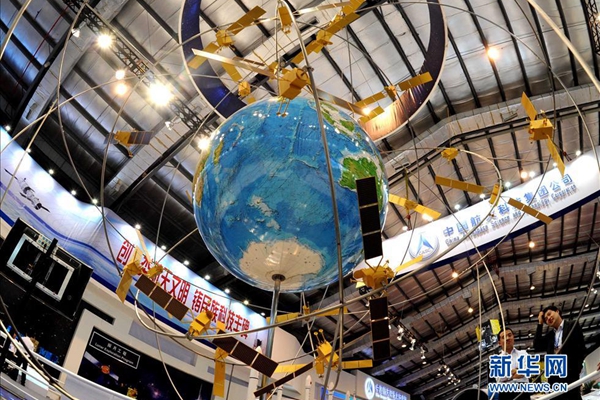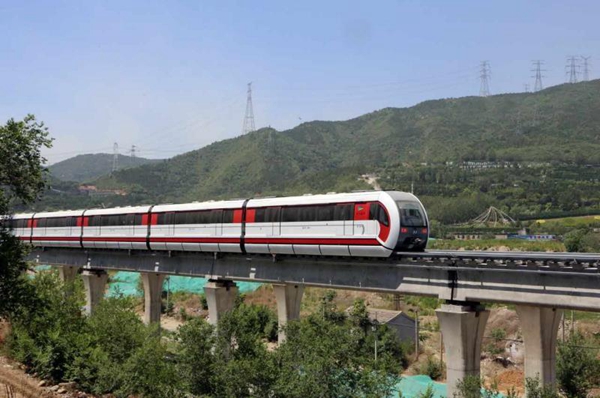China launches first X-ray space telescope
|
|
|
A Long March-4B rocket carrying X-ray space telescope to observe black holes, pulsars and gamma-ray bursts blasts off from Jiuquan Satellite Launch Center in northwest China’s Gobi Desert, June 15, 2017. [Photo/Xinhua] |
China launched its first X-ray space telescope to observe black holes, pulsars and gamma-ray bursts, via a Long March-4B rocket from Jiuquan Satellite Launch Center in northwest China’s Gobi Desert at 11 a.m. Thursday.
The 2.5-tonne Hard X-ray Modulation Telescope (HXMT), dubbed Insight, was sent into an orbit of 550 kilometers above the earth to help scientists better understand the evolution of black holes, and the strong magnetic fields and the interiors of pulsars.
Through the telescope, scientists will also study how to use pulsars for spacecraft navigation, and search for gamma-ray bursts corresponding to gravitational waves.
The result of the wisdom and efforts of several generations of Chinese scientists, Insight is expected to push forward the development of space astronomy and improve space X-ray detection technology in China.
There is no soft or hard Brexit
I do not know how many more times I have to argue the obvious. There is Brexit, or there is staying in the EU. The EU has made it crystal clear you cannot stay in the single market without accepting freedom of movement and paying contributions, two things the people clearly rejected in the referendum and again in the General election. You cannot stay in the Customs Union if you want to have free trade deals with the rest of the world.
The Labour Manifesto in 2017 stated they accepted the decision of the referendum. They set out policies to negotiate a range of new free trade and investment agreements with non EU countries that assume we are leaving the single market and the Customs Union. The Manifesto talked positively about a new trading relationship they wished to negotiate, again assuming the current one stemming from single market and customs union membership had gone. Their document stated that “freedom of movement will end when we leave the EU”. The Conservative and DUP Manifestos also made clear we will be leaving the single market and Customs Union and looked forward to new free trade deals around the world.
So we have overwhelming agreement, endorsed by 86% of the voters in the election, that the UK will run her own immigration policy and her own trade policy on leaving. People in the UK have to grasp that arguing amongst ourselves about what our negotiating position should be, when the government has already set one out, can only help those in the EU institutions who wish to harm the UK. Fortunately most of the member states want access to our market and want good relations with us for a wide variety of reasons. Fortunately also the Lisbon Treaty has in Clause 8 a clear legal requirement that the EU itself seeks an “area of prosperity and good neighbourliness” with us. We know how keen Commissioners are to stick to the law of the Treaty.
I am optimistic about the negotiations. It would help our country if more people got behind the government’s stance. After all what the government wants is what all say they want – good access to the single market, and many collaborations and joint workings based on bilateral agreement. To change stance now would undermine us. We negotiate with the rest of the EU, not amongst ourselves!
China’s BeiDou navigation system to expand to B&R nations
|
|
|
A model of the BeiDou Satellite Navigation system exhibited in Zhuhai [File photo/Xinhua] |
Developers involved with the BeiDou Satellite Navigation system are preparing to make the next step forward in turning the Chinese-produced system into a major global player.
The BeiDou Navigation Satellite System is world’s fourth navigation satellite system, which also includes the GPS system run by the United States, the GLONASS system in Russia and the Galileo system developed by the European Union.
With its accuracy reaching centimeter-levels, the system can provide precise positioning services for urban construction, as it will be able to help accurately place underground gas and and power lines, along with other connections necessary for today’s modern buildings.
Miao Qianjun, secretary-general of Global Navigation Satellite System and Location Based Service Association of China says, “The National BeiDou Precise Service Network so far covers 317 cities across the country, and can provide precise location information, accurate time information and short-message communication service in almost all application areas.”
Steps are now being taken to make Beidou a global network.
“Next month we’re going to officially start networking and launching the BeiDou-3 system, which will provide global coverage. Probably in mid-July, we will launch the first two satellites on one rocket,” Ran Chengqi, director of the China Satellite Navigation System Management Office says. “By the end of next year, we will have put 18 new 18 satellites into orbit, including between six and eight satellites slated for this year.”
This should allow Beidou to start offering services to customers in countries participating in the Belt and Road Initiative by next year.
Over 30 million chips which run the Beidou system have been sold to manufacturers of mobile phones and other systems which can use navigation technology.
Beidou’s high-precision board cards and antennas, for industrial use, are now being exported to more than 70 countries and regions, over 30 of which are along the Belt and Road.
“For example, Beidou can be used to help with the construction of overseas ports and offer service to our country’s high-speed rail services. After the Beidou system becomes available globally, those countries will be able to use the Beidou system to help boster their national economy and improve people’s livelihood,” Sun Jiadong of the Chinese Academy of Sciences says.
China started building its own satellite navigation system in 2000, sending up just two satellites at first to end Chinese dependence on the United States’ GPS system.
Since 2012, Beidou has been able to provide navigation, time and text messaging services across the Asia and Pacific region.
As of last year, satellite navigation became a 30 billion U.S. dollars business in China, with Beidou able to make up around 30-percent of the market share.
By 2020, Chinese officials anticipate satellite navigation services will end up being close to a 60-billion U.S. dollar industry.
Maglev train nears completion in Beijing
|
|
|
A maglev train undergoes testing recently on Beijing’s new S1 line, which is scheduled to open later this year. [Photo/China Daily] |
Beijing’s first mid- to low-speed magnetic levitation railway line is preparing for its debut later this year.
Services on Line S1 will run from Shimenying station in western Mentougou district to Pingguoyuan station in Shijingshan district, a transfer station for Line 1.
The maglev line will have eight stations stretching over 10.2 kilometers and will run at a maximum speed of 100 kilometers per hour. The whole journey will take about 20 minutes, including the time for passengers to get on and off.
The train, manufactured by CRRC Tangshan Co in Hebei Province, has six cars and is designed to carry 1,032 passengers at a time.
According to the company, 10 trains will be put into use in the first stage of operation.
The main feature of the maglev train is that it doesn’t have wheels, unlike the current metro trains. That makes it more comfortable and safer, according to CRRC Tangshan.
Using electromagnetic forces, the trains are elevated about 1 centimeter above the tracks, avoiding friction and resulting in a smooth ride.
Tracks are specially designed to prevent the trains from overturning or derailing, the company said.
The Chinese Academy of Sciences’ Institute of Electrical Engineering was quoted by China Central Television as saying that the magnetic fields of the maglev trains have less effect on human health than TV sets.
The debugging process for Line S1 is expected to end in November, followed by a monthlong trial run, said Sun Hechuan, deputy general manager of Beijing Enterprises Holdings Maglev Technology Development Co.
The country’s first domestically designed and manufactured maglev line began operating a year ago in Changsha, capital of Hunan province.



